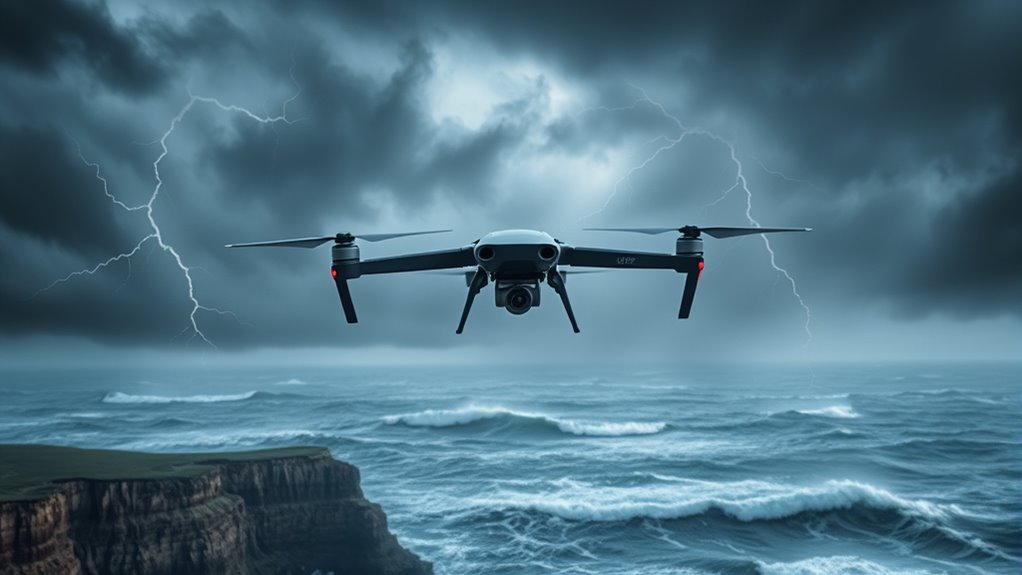During the 2025 Atlantic hurricane season, you should stay vigilant with weather updates from multiple sources like national services, satellite data, and aviation briefings. Prioritize safety protocols, review forecasts regularly, and have backup plans ready. Flexibility is key—be prepared to postpone or reroute flights if storms approach. Communicate clearly with your team and adapt quickly to changing conditions. Keep informed on storm developments, and you’ll find more ways to stay safe and efficient during this active season.
Key Takeaways
- Continuously monitor multiple weather sources for hurricane development, tracks, and wind patterns throughout the season.
- Develop and review comprehensive safety protocols, including alternate routes and emergency landing plans.
- Postpone or reroute flights if forecasts indicate approaching hurricanes or severe weather conditions.
- Maintain clear communication with the team and ground support for real-time weather updates and safety adjustments.
- Stay flexible, promptly adapt flight plans, and prioritize safety to mitigate risks during hurricane season.

Are you prepared to navigate the challenges of soaring flights during the 2025 Atlantic hurricane season? As a pilot or flight planner, understanding how to interpret weather forecasting is essential. Precise weather forecasts provide critical insights into storm development, wind patterns, and potential hazards. Relying on dependable sources for up-to-the-minute updates helps you make informed decisions, reducing risks associated with unexpected weather shifts. Keep in mind that hurricane seasons can be unpredictable, so staying vigilant and proactive is key to maintaining safety.
Prepare for 2025 hurricane season with vigilant weather monitoring and proactive safety planning.
In planning your soaring flights, you must prioritize safety protocols above all. Before every flight, review the latest weather forecasts, paying close attention to any signs of tropical storm development or shifting wind conditions. It’s wise to establish a clear emergency plan, including alternate routes and safe landing sites, in case weather conditions deteriorate unexpectedly. Always ensure your equipment is in top condition, and double-check your communication devices to stay connected with ground support or emergency services if needed. Remember, safety protocols aren’t just guidelines—they’re your first line of defense against the dangers posed by hurricanes and severe weather.
Monitoring weather forecasts is an ongoing process, especially during hurricane season. As you prepare for each flight, check multiple sources—national weather services, specialized aviation weather briefings, and real-time satellite data—to get a thorough picture of current and forecasted conditions. Pay particular attention to storm tracks, wind shear, and precipitation patterns. If forecasts indicate potential hurricane activity nearby, consider postponing or rerouting your flight to avoid dangerous zones altogether. Flexibility and quick decision-making can prevent accidents and save lives.
Additionally, it’s crucial to communicate your plans clearly with your team and ground support. Share your weather evaluations and safety protocols, and establish check-in procedures throughout your flight. During soaring, stay alert for sudden weather changes, and always be prepared to descend or alter your route if conditions worsen. Remember that hurricanes can generate turbulent air, unpredictable wind gusts, and severe turbulence, all of which threaten the safety of your flight. By integrating vigilant weather forecasting with strict safety protocols, you minimize your exposure to these hazards. Incorporating accurate weather data into your planning can significantly improve your ability to anticipate and respond to evolving conditions.
Ultimately, soaring during the 2025 Atlantic hurricane season demands meticulous planning, continuous monitoring, and unwavering commitment to safety. By leveraging accurate weather data and adhering to proven safety protocols, you can navigate the season’s challenges more confidently. Staying informed, flexible, and prepared ensures that your soaring adventures remain safe and enjoyable, even amid unpredictable hurricane activity.
Frequently Asked Questions
How Do Hurricane Forecasts Influence Soaring Flight Planning?
Hurricane forecasts greatly influence your soaring flight planning by helping you anticipate potential hurricane impacts. You should monitor forecast accuracy closely, as early warnings can allow you to adjust routes or delay flights to avoid dangerous weather. Staying updated with reliable sources ensures you respond promptly to changing conditions, minimizing risks. Your proactive planning based on forecast accuracy helps ensure a safe and successful soaring experience during hurricane season.
What Safety Protocols Are Recommended for Hurricane Season Soaring Flights?
Like a captain steering through stormy seas, you must prioritize safety during hurricane season. Always establish robust emergency communication plans, ensuring quick contact with rescue teams and fellow pilots. Conduct thorough weather pattern analysis before each flight, monitoring updates constantly. If conditions threaten safety, don’t hesitate to delay or cancel flights. Staying vigilant and prepared helps you navigate the skies safely, even amid the chaos of hurricane season.
How Can Pilots Track Hurricane Developments in Real-Time?
You can track hurricane developments in real-time by monitoring satellite imagery, which provides up-to-date visuals of storm progressions, and by analyzing data from weather balloons, which offer critical atmospheric insights. Regularly check official meteorological sources like the National Hurricane Center, and use weather apps with real-time alerts. Combining satellite images with weather balloon data helps you stay informed about storm intensity and movement, ensuring safer soaring flight planning.
What Equipment Is Essential for Hurricane-Aware Soaring Flights?
Think of your equipment as a lighthouse guiding your journey through stormy skies. Essential tools include hurricane navigation systems and storm tracking tools, which act as your compass and radar, providing real-time updates. A reliable GPS, weather radio, and portable radar help you stay ahead of brewing storms, ensuring your safety and success. With these, you turn potential chaos into controlled adventure, honoring the storm’s power while respecting its danger.
Are There Specific Regions to Avoid During the 2025 Atlantic Hurricane Season?
You should avoid regions prone to climate change impacts and known as historical hurricane zones, especially along the Gulf Coast, Southeastern U.S., and Caribbean. These areas experience increased hurricane activity and unpredictable weather patterns during the 2025 Atlantic hurricane season. Staying clear of these zones minimizes risks, as climate change worsens storm intensity and frequency, making flying unsafe. Always monitor official weather updates and hurricane forecasts before planning your soaring flights.
Conclusion
By staying vigilant, preparing thoroughly, and monitoring updates constantly, you can navigate the challenges of soaring during the 2025 Atlantic hurricane season. Anticipate storms, adapt quickly, and prioritize safety above all. Remember, planning ahead isn’t just about avoiding danger; it’s about embracing the skies with confidence, flexibility, and respect. With these steps in mind, you’ll soar responsibly, stay safe, and enjoy the thrill of flight even amid the season’s fiercest storms.
With a heart that soars as high as the skies, Aria, affectionately known as “Skylark,” is the driving force behind Soaring Skyways. Her journey into the gliding world began as a young dreamer gazing up at the soaring birds, yearning to experience the weightlessness and freedom they embodied. With years of experience both in the cockpit and behind the scenes, Aria’s commitment to the gliding community is unwavering.








